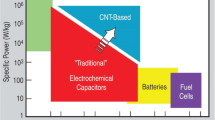Abstract
Electrochemical double layer capacitors, also referred to as supercapacitors, are a promising technology in the field of energy storage. Carbon nanotube (CNT)-based supercapacitors are particularly interesting because of CNTs’ high surface area and conductivity. CNT supercapacitors can potentially be used in hybrid electric vehicles due to their higher power density. Comparing energy storage systems that store energy in different ways, such as batteries, fuel cells, supercapacitors, and flywheels, requires that an appropriate set of performance data be collected. A Ragone plot is a log-log plot of a device’s energy density versus power density, giving insight into its operational range. A method to obtain Ragone plots for CNT-based supercapacitors in a three-terminal electrochemical cell was adapted from a technique to test commercial capacitors for electric vehicles. Ragone plots for different types of as-grown CNT electrodes in different electrolytes are presented, along with the procedural details of this new method to obtain electrode-specific energy and power densities. Additionally, a theoretical weight calculation for a carbon nanotube film was derived and validated with a direct weight measurement of a CNT film. This weight was used in the specific energy and power densities for the Ragone plot.
Similar content being viewed by others
References
R.H. Baughman, A.A. Zakhidov, W.A. de Heer: Carbon nanotubes—The route toward applications. Science297, (5582) 787 (2002)
T. Christen, M.W. Carlen: Theory of Ragone plots. J. Power Sources91210 (2000)
D. Dunn-Rankin, E. Martins Leal, D.C. Walther: Personal power systems. Prog. Energy Combust. Sci.31422 (2005)
T. Christen, C. Ohler: Optimizing energy storage devices using Ragone plots. J. Power Sources110107 (2002)
J. Chmiola, G. Yushin, Y. Gogotsi, C. Portet, P. Simon, P.L. Taberna: Anomalous increase in carbon capacitance at pore sizes less than 1 nanometer. Science313, (5794) 1760 (2006)
J.R. Miller, A.F. Burke Electric Vehicle Capacitor Test Procedures Manual(Idaho National Engineering Laboratory, U.S. Department of Energy 1994)
B.E. Conway Electrochemical Supercapacitors: Scientific Fundamentals and Technological Applications(Kluwer Academic/Plenum, New York 1999)698
H. Cui, O. Zhou, B.R. Stoner: Deposition of aligned bamboo-like carbon nanotubes via microwave plasma enhanced chemical vapor deposition. J. Appl. Phys.886072 (2000)
I. Plitz, A. Dupasquier, F. Badway, J. Gural, N. Pereira, A. Gmitter, G.G. Amatucci: The design of alternative nonaqueous high power chemistries. Appl. Phys. A82615 (2005)
A. Peigney, C. Laurent, E. Flahaut, R.R. Bacsa, A. Rousset: Specific surface area of carbon nanotubes and bundles of carbon nanotubes. Carbon39507 (2001)
V.N. Popov: Carbon nanotubes: Properties and application. Mater. Sci. Eng.43, (3) 61 (2004)
H. Cui Nucleation and growth of nanoscaled one-dimensional materials. Ph.D. Thesis, Applied and Materials ScienceUniversity of North Carolina at Chapel Hill (2001)
V.V.N. Obreja: On the performance of supercapacitors with electrodes based on carbon nanotubes and carbon activated material—A review. Physica E402596 (2008)
C. Ye, Z.M. Lin, S.Z. Hui: Electrochemical and capacitance properties of rod-shaped MnO2 for supercapacitor. J. Electrochem. Soc.152, (6) A1272 (2005)
H. Chu, Q. Lai, Y. Hao, Y. Zhao, X. Xu: Study of electrochemical properties and the charge/discharge mechanism for Li4Mn5O12/MnO2-AC hybrid supercapacitor. J. Appl. Electrochem.39, (10) 2007 (2009)
H-Y. Chu, Q-Y. Lai, L. Wang, J-F. Lu, Y. Zhao: Preparation of MnO2/WMNT composite and MnO2/AB composite by redox deposition method and its comparative study as supercapacitive materials. Ionics16, (3) 233 (2009)
A.E. Fischer, M.P. Saunders, K.A. Pettigrew, D.R. Rolison, J.W. Long: Electroless deposition of nanoscale MnO2 on ultraporous carbon nanoarchitectures: Correlation of evolving pore-solid structure and electrochemical performance. J. Electrochem. Soc.155, (3) A246 (2008)
Author information
Authors and Affiliations
Corresponding author
Rights and permissions
About this article
Cite this article
Raut, A.S., Parker, C.B. & Glass, J.T. A method to obtain a Ragone plot for evaluation of carbon nanotube supercapacitor electrodes. Journal of Materials Research 25, 1500–1506 (2010). https://doi.org/10.1557/JMR.2010.0192
Received:
Accepted:
Published:
Issue Date:
DOI: https://doi.org/10.1557/JMR.2010.0192




